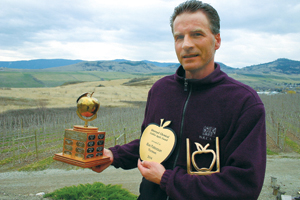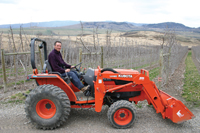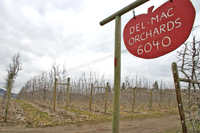
Features
Production
Research
B.C. Golden Apple winner is a quick study
is a quick study
April 18, 2008 By Alanna Jorde
Apparently, Ron Pattermann
“didn’t know anything” about growing apples when he purchased the
22-acre Del-Mac Orchards in 1990. He’s too humble to say so, but he
must be a quick study. His bright, shiny 2004 Golden Apple Award and
companion plaques attest to that.
 |
| Ron Patterman. Photo by Alanna Jorde |
Apparently, Ron Pattermann “didn’t know anything” about growing apples when he purchased the 22-acre Del-Mac Orchards in 1990. He’s too humble to say so, but he must be a quick study. His bright, shiny 2004 Golden Apple Award and companion plaques attest to that.
Pattermann says he had a good teacher – his father-in-law, Jack Shore. A well-respected Okanagan Valley fruit grower, Shore thought he had retired after 30 years in the business only to discover he had an affliction common to many long-time farmers. He “couldn’t sit still well.” After a seven-year break, Shore was itching to get back into farming and as Pattermann was also “due for a change” after spending years toiling in the automotive industry, the two men decided the time was ripe to buy the Vernon orchard together.
Today, Del-Mac Orchards boasts six varieties of apple trees, ranging in age from one to 13 years, arranged in a Super Spindle system, complete with drip irrigation. The Gala, Ambrosia, Spartan, Golden Delicious, Jonagold and Braeburn trees cover 17.5 acres and grow in rows spaced about nine feet apart with a tree distance within the rows ranging anywhere from 15 to 26 inches.
The orchard produced very high yields of 60 to 70 per cent by only the third year of operation, which Pattermann credits to the Super Spindle system. On the other hand, the productivity level also tends to be cyclical, based on Mother Nature’s own rhythm. Last year, for instance, one acre of Golden Delicious trees yielded 91 bins. “We’ll never do that again,” says Pattermann.
 |
| Working on the farm Photo by Alanna Jorde |
 |
| Pattermann’s Del-Mac Orchard Photo by Alanna Jorde |
Still, good management techniques, including “proper pruning, thinning and nutrition,” are essential to ensuring a good crop each year, he adds, before revealing that he tends to be quite “fussy” about what goes on in his orchard and is constantly striving to improve his operations. He and his father-in-law work closely with all of their hired help. They spend all eight weeks of the picking season in the orchard, demonstrating the best picking methods to their pickers and “pre-grading in the orchard.” Pattermann instructs all of his pickers to discard any apple that has a mark on it that’s larger than the size of their pinky fingernail.
It also helps to be curious. Pattermann enjoys touring other operations to “see what others are doing” and learning about new techniques at seminars and field trips where fruit growers can brainstorm and share their best practices.
Pattermann saves time by using an electric hedge trimmer, powered by a generator he mounts to his tractor, to trim the tops of his trees. He estimates that it takes him about 10 days to do a job that would take about a month to complete if he were to do it by hand. He also prunes and thins his trees at the same time in late June and early July. Not only does this save him time, “the apples are in the sun longer and redden up quicker.”
Since “diversification” and “agri-tourism” are the buzzwords of the industry these days, Pattermann is thinking about building a farmer’s market on his orchard with a view to attracting clientele from a subdivision that will soon be constructed in his neighbourhood. He is also toying with the idea of replanting a portion of his orchard with Honey Crisp trees. The large, sweet, crisp fruit is the apple world’s newest sensation and pays “really well.”
As for his short-term future, Pattermann says a drastic 50 per cent drop in apple prices means he will be securing a line of credit and cutting back on expenses for the first time since he became a fruit grower. “Farming is a gamble,” he says philosophically, after explaining that prices have been very favourable for B.C. apple producers for the past few years ever since “25,000 acres were ripped out in Washington State and production there was down.” It’s a good thing, he adds, that “government programs are there to back us up.”
Pattermann grew up surrounded by green alfalfa and golden wheat in nearby Armstrong, B.C., so he knew to expect long hours and backbreaking physical labour when he started his business. But he was surprised by the flows of cash in and out of his operation. “I can’t believe the amount of money that goes out the door … how much money is needed to run a farm,” he says.
Pattermann and Shore put their first trees in the ground in 1992, but Pattermann did not quit his automotive sales job until 2001, when about 70 per cent of the orchard was planted. Today, he has no doubt his “automotive days are over” but he misses the social aspect of his previous employment. Farming, he says wistfully, is a very solitary venture.
“You’re by yourself a good part of the day. It’s just you and the dog.”
Still, he enjoys the freedom and flexibility of being his own boss, which allows him to have an active role in the activities of his two growing daughters, who are 10 and 13.
Print this page